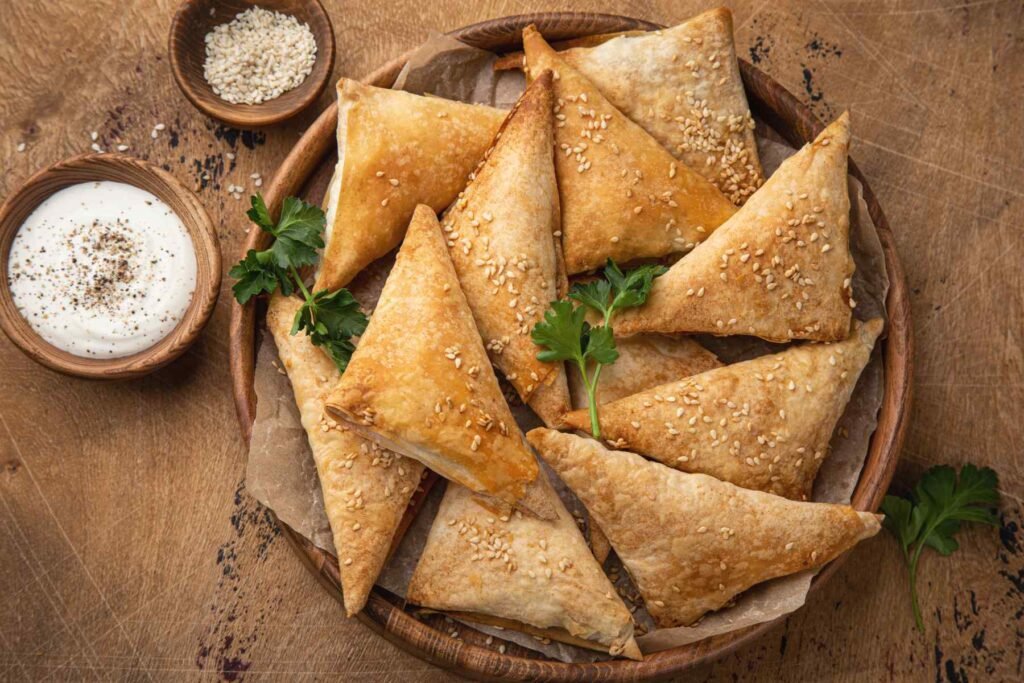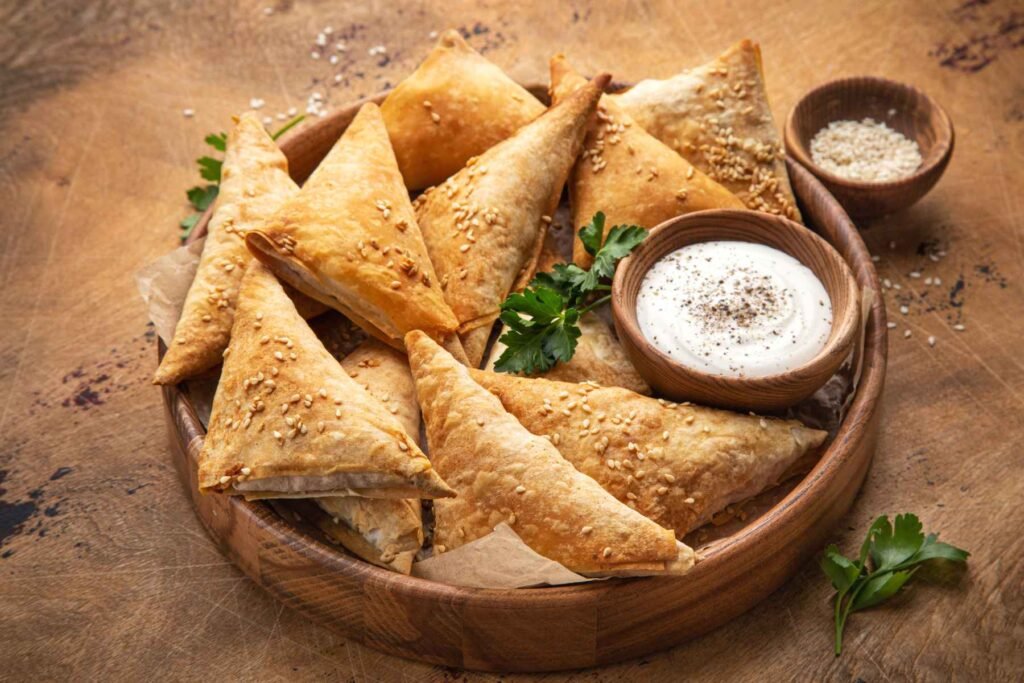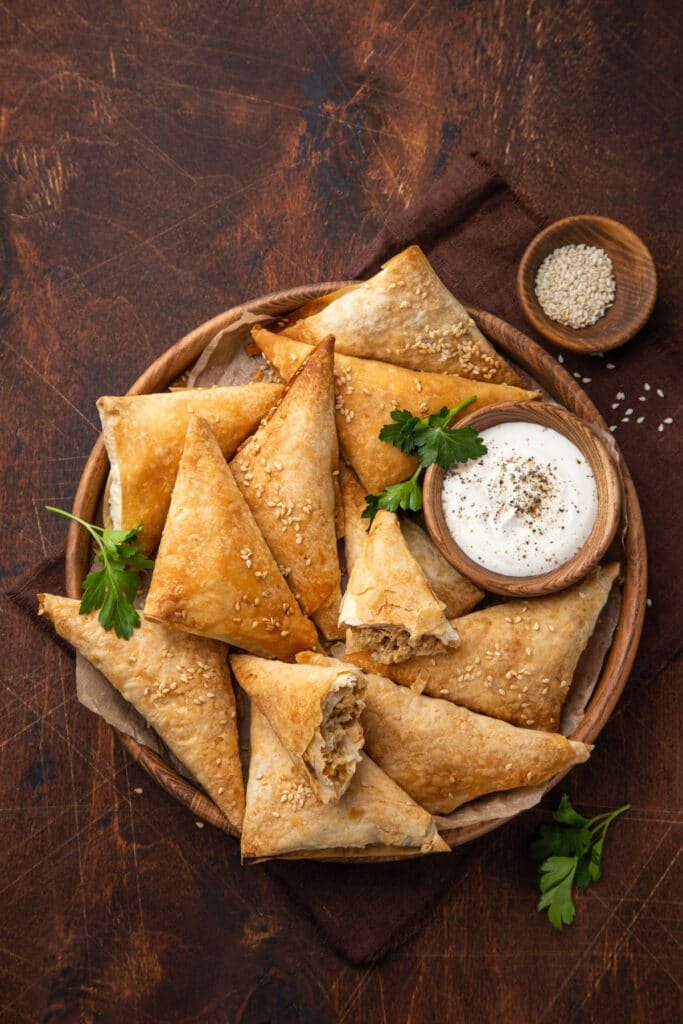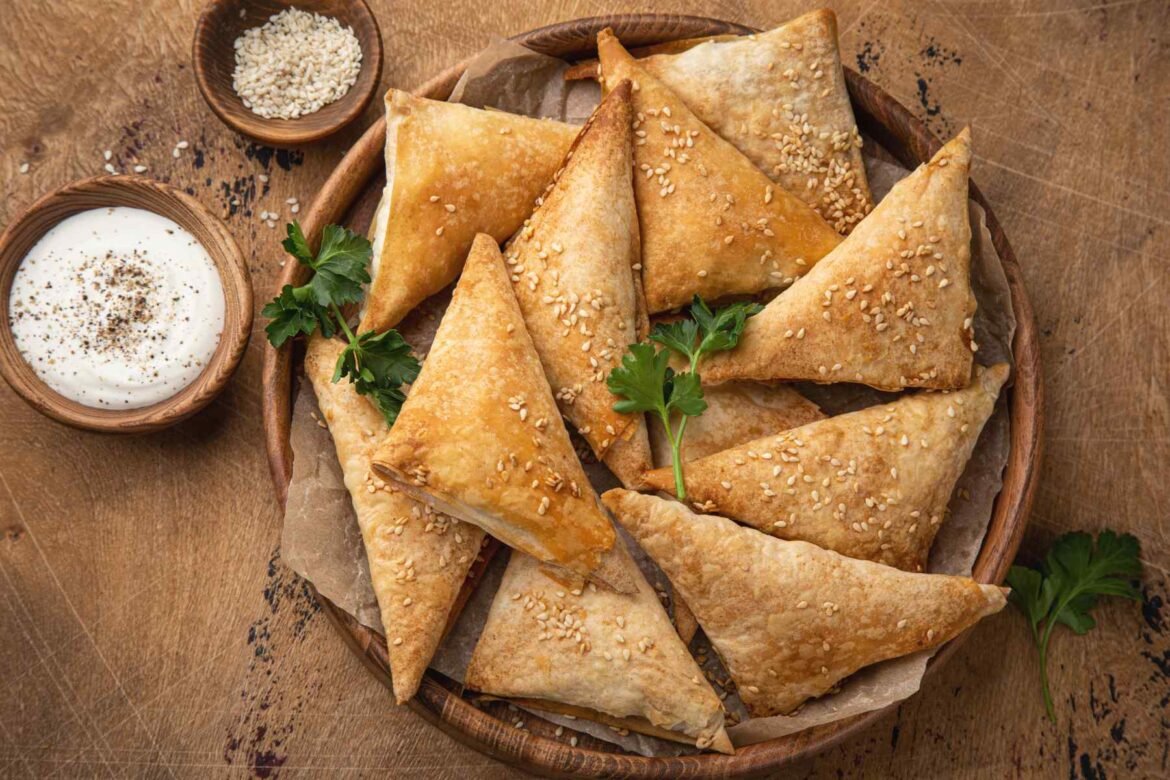Lamb Samosa Recipe, filled dumplings, are excellent snacks for in-between meals when travelling. In India and its neighbouring countries, they are considered typical street food and are available almost everywhere.
The deep-fried dumplings are traditionally prepared vegetarian or vegan and are most often filled with aloo, i.e. potatoes, at least in central and southern India. Onions and peas are also indispensable and, of course, spices. Samosas should never taste bland, but they shouldn’t be too spicy either. The classic accompaniment is chutney, often coconut chutney or mint chutney.
Samosa From the oven
In India these dumplings are always deep-fried, at home I usually make them in the oven, as deep-frying is more (time)consuming – although I have to admit that they are quite good when fried out in fat

Baking Samosa
Place the finished Samosa on a baking tray lined with baking paper and brush with soy milk (vegan) or a beaten egg (vegetarian) before placing them in the oven. Bake in a preheated oven at 190°C top for around 25 minutes until golden.
If you want to deep-fry them, heat the oil until bubbles appear on a wooden stick. Fry the samosas in the hot oil over medium heat until golden brown on each side (about 2-3 minutes per side). Remove with a slotted spoon or kitchen tongs and drain on kitchen paper.

What is samosa dough made of?
Samosas are a type of savory pastry that are popular in many parts of the world, including India, Pakistan, and Nepal. The dough used to make samosas is typically made from flour, water, and a small amount of oil or ghee (clarified butter). The dough is mixed together until it forms a smooth and pliable consistency, and it is then rolled out into thin sheets.
To make the dough for samosas, you will need:
- 2 cups all-purpose flour
- 1/2 teaspoon salt
- 3 tablespoons oil or ghee
- 3/4 cup water (more or less, as needed)
To make the dough, combine the flour and salt in a large mixing bowl. Add the oil or ghee and mix until the mixture resembles breadcrumbs. Gradually add the water, a little at a time, stirring constantly until the dough comes together in a smooth ball. Knead the dough for a few minutes until it becomes smooth and elastic. Cover the dough with a damp cloth and set aside to rest for 30 minutes to an hour.
After the dough has rested, divide it into equal-sized balls and roll each ball out into a thin sheet on a lightly floured surface. You can then use the dough to make samosas by cutting it into desired shapes and filling it with your choice of filling.
Are lamb samosas healthy?
Lamb samosas can be a part of a healthy diet, but it is important to consider the overall nutritional content of the dish and to be mindful of portion sizes. Like any food, it is important to enjoy lamb samosas in moderation as part of a balanced diet.
Samosas are typically made by wrapping a savory filling in a thin layer of dough and deep-frying them until they are crispy and golden. While this can make them a tasty snack or appetizer, it is worth noting that deep-fried foods are generally higher in fat and calories compared to foods that are baked or grilled.
The nutritional content of lamb samosas will depend on the specific ingredients used and the method of preparation. For example, using lean cuts of lamb and incorporating vegetables into the filling can help to increase the nutritional value of the dish. It is also a good idea to choose a healthier cooking method, such as baking or grilling, rather than deep-frying the samosas.

What are the essentials of making a samosa?
To make samosas, you will need the following ingredients and equipment:
- Flour: You will need flour to make the dough for the samosa pastry. All-purpose flour is a good choice, but you can also use whole wheat flour or a combination of the two.
- Oil or ghee: You will need a small amount of oil or ghee to make the dough for the pastry. Oil or ghee helps to make the dough more pliable and easier to work with.
- Water: You will need water to mix with the flour to form the dough for the pastry. The amount of water you need will depend on the type of flour you are using and the humidity in the air.
- Filling: You can use a wide variety of fillings for samosas, including vegetables, meat, and legumes. The filling should be diced or finely chopped and seasoned to taste.
- Spices: You can use a variety of spices to add flavor to the filling for your samosas. Some popular choices include cumin, coriander, garam masala, and turmeric.
- Deep fryer or large pot: You will need a deep fryer or a large pot to deep-fry the samosas. Be sure to use a thermometer to ensure that the oil is at the correct temperature.
- Rolling pin: You will need a rolling pin to roll out the dough for the pastry.
- Round cutter or glass: You will need a round cutter or a glass to cut out circles from the dough for the pastry.
- Brush: You will need a brush to brush the edges of the circles with water to help seal the samosas.
- Frying thermometer: It is a good idea to use a frying thermometer to ensure that the oil is at the correct temperature when deep-frying the samosas.
To make samosas, you will need to mix together the flour, oil or ghee, and water to form the dough for the pastry. After the dough has rested, roll it out into thin sheets and cut out circles using a round cutter or a glass. Fill the circles with your choice of filling and fold them over to form a triangle shape. Brush the edges with water to help seal the samosas and deep-fry them until they are crispy and golden.

Why my samosa is not crispy?
There are several factors that can affect the crispiness of samosas. Here are some possible reasons why your samosas may not be as crispy as you would like:
- The oil temperature is too low: Samosas should be deep-fried at a temperature of around 350-375°F (180-190°C). If the oil is not hot enough, the samosas will absorb more oil and may become soggy rather than crispy.
- The dough is too thick: If the dough for the pastry is too thick, the samosas will take longer to cook and may become soggy. It is important to roll the dough out as thinly as possible to ensure that the samosas are crispy.
- The samosas are not cooked long enough: Samosas should be cooked until they are golden brown and crispy. If they are not cooked for long enough, they may be undercooked and not as crispy as desired.
- The samosas are overcrowded in the fryer: If there are too many samosas in the fryer at once, they may not cook evenly and may become soggy in some areas. Be sure to give the samosas plenty of space in the fryer to ensure that they cook evenly and become crispy.
If you are having trouble getting your samosas to turn out crispy, try adjusting the oil temperature, rolling the dough out more thinly, cooking the samosas for longer, and giving them enough space in the fryer.

What oil are samosas fried in?
Samosas are typically deep-fried in a type of oil with a high smoke point, such as vegetable oil, peanut oil, or canola oil. These oils can withstand the high heat of deep-frying without breaking down or becoming rancid, which can affect the taste and quality of the finished dish.
It is important to choose an oil with a high smoke point when deep-frying samosas to ensure that the oil stays hot enough to cook the samosas evenly and to achieve a crispy texture. Oils with lower smoke points, such as olive oil, are not suitable for deep-frying as they can break down and become rancid at high temperatures.
When deep-frying samosas, it is important to use a frying thermometer to ensure that the oil is at the correct temperature. The ideal temperature for deep-frying samosas is around 350-375°F (180-190°C). Be sure to carefully monitor the temperature of the oil while cooking to ensure that the samosas turn out crispy and golden.
Is samosas good for weight loss?
Samosas can be a part of a weight loss diet, but it is important to be mindful of portion sizes and the overall nutritional content of the dish. Samosas are typically made by wrapping a savory filling in a thin layer of dough and deep-frying them until they are crispy and golden. While this can make them a tasty snack or appetizer, it is worth noting that deep-fried foods are generally higher in fat and calories compared to foods that are baked or grilled.
To make samosas a healthier choice for weight loss, you can try using a lower-fat filling and a healthier cooking method, such as baking or grilling, rather than deep-frying the samosas. You can also choose a healthier type of dough, such as a whole wheat dough or a dough made with a combination of whole wheat and all-purpose flour.
It is also important to be mindful of portion sizes when incorporating samosas into a weight-loss diet. Even if you are using a healthier filling and cooking method, it is still important to pay attention to how many samosas you are consuming and to balance them with other nutritious foods as part of a balanced diet.

Lamb Samosa Recipe
Servings: 4 Preparation:30 minutes Cooking time: 10 minutes Calories: 273 Fat: 4g
450 g minced lamb
1 cup fresh/frozen peas
1 small onion each
1 tsp olive oil
½ tsp curry powder
½ tsp smoked paprika
2 cups grated cheese
pinch of salt
Pinch of black pepper
25 each 8″ square spring roll wrappers
2 tbsp flour
2 tsp water
Instructions
In a pan over low heat, sauté the onions in the olive oil.
Add the curry powder and smoked paprika to the sautéed onions and lightly fry, stirring constantly, for 2-3 minutes.
Add the ground beef and continue to stir, turning the heat to medium-high.
Once the meat is no longer pink, add the peas and cook for 10 minutes.
Taste the meat and adjust the salt if necessary.
Leave the filling to cool completely
Preheat oven to 180 degrees.
To assemble, simply cut the spring roll leaves in half to form rectangles, place about 1 tsp of the filling on top of the dough and fold some of the grated cheese into triangles.
Seal the dough with the simple flour and water mixture as shown above.
Bake in the oven until crispy golden brown.

Ingredients
- 450 g minced lamb
- 1 cup fresh/frozen peas
- 1 small onion each
- 1 tsp olive oil
- ½ tsp curry powder
- ½ tsp smoked paprika
- 2 cups grated cheese
- pinch of salt
- Pinch of black pepper
- 25 each 8" square spring roll wrappers
- 2 tbsp flour
- 2 tsp water
Instructions
- In a pan over low heat, sauté the onions in the olive oil.
- Add the curry powder and smoked paprika to the sautéed onions and lightly fry, stirring constantly, for 2-3 minutes.
- Add the ground beef and continue to stir, turning the heat to medium-high.
- Once the meat is no longer pink, add the peas and cook for 10 minutes.
- Taste the meat and adjust the salt if necessary.
- Leave the filling to cool completely
- Preheat oven to 180 degrees.
- To assemble, simply cut the spring roll leaves in half to form rectangles, place about 1 tsp of the filling on top of the dough and fold some of the grated cheese into triangles.
- Seal the dough with the simple flour and water mixture as shown above.
- Bake in the oven until crispy golden brown.
If you like our recipe, would you please support us by sharing it?
